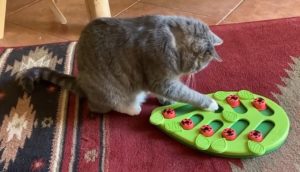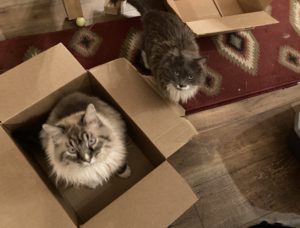
At the veterinary clinic where I work, I often hear people say when I ask about their cat’s activity and play, “she sleeps most of the time and meows a lot at night. She doesn’t play – she’s an older cat”. How much of these behaviors is due to “normal” aging? How much is due to other medical conditions or a declining brain?
Cognitive Dysfunction Syndrome in cats or cat dementia refers to the decline in mental abilities associated with aging.
Cat dementia results from damage to the brain. As your cat ages, the the numbers of molecules called free radicals are no longer balanced out by the antioxidants in his body. These free radicals are reactive and cross the blood-brain barrier, damaging cells in the brain.
Changes in blood flow to the brain can also cause damage by starving the neurons of oxygen. High blood pressure, heart disease, anemia – are all conditions that alter the flow of blood to the brain.
How can we tell if our cats are undergoing mental decline? Is there anything we can do about it?
VISHDAAL – behavior changes
Changes in behavior can indicate if your cat’s mental state has declined. The acronym VISHDAAL summarizes the behavior changes we need to monitor in our senior cats, from the most prevalent (vocalizing) to least frequent (changes in learning and memory).
V = vocalization
I = changes in interaction with us and other pets
S = changes in sleep-wake cycle
H = house soiling
D = disorientation
A = changes in activity
A = anxiety
L = learning and memory
How do we sort out behavior changes due to disease and those due to declining mental capacity?
Changes in behavior signal the onset of cognitive decline but they may also arise from other health issues:
- Cats with untreated high blood pressure or hyperthyroidism may meow at night (vocalizing).
- Cats with untreated hyperthyroidism may be restless and beg us for food (changes in interactions and sleep).
- Kidney disease can be accompanied by increased thirst and urination which may result in house soiling (house soiling)
- Cats with osteoarthritis may have difficulty accessing the litter box (house soiling).
behavior changes: disease vs Dementia
Regular veterinary exams and diagnostics can identify medical conditions such as high blood pressure, hyperthyroidism, and osteoarthritis. If behavioral changes persist after treating these other medical conditions, your cat may have CDS or cat dementia.
Cat dementia is a “diagnosis of exclusion” – it is the diagnosis that remains after all the other possible diagnoses have been eliminated. Cat dementia will usually have a slow onset and behavioral symptoms will gradually get worse.
Cognitive Dysfunction (CDS) cannot be cured but management can reduce the symptoms and improve the Quality of Life for both you and your cat.
managing cat dementia
- environmental enrichment/modification
- dietary supplements
- therapeutic diets
- medication
Environmental enrichment/modification
In the early stages of cat dementia, enrichment increases mental stimulation, leading to the growth and survival of neurons, preserving the thinking processes. Enrichment should be tailored to the individual cat. For example, some cats prefer high places; others are “ground dwellers”. Arthritic cats will not have the range of motion of healthier cats but will still enjoy play that does not require lots of jumping.
Ways to enrich your cat’s environment:
- play – interactive play and toys
- scent enrichment – catnip, silvervine
- food puzzles
- motion – climbing (cat trees) and exploring (cardboard boxes)
- supervised outdoor access
As CDS progresses…
Environmental changes become stressful and confusing. Cats with severe cat dementia need an environment that does not change much – daily routines and feeding schedules must be maintained. Litter boxes and feeding stations need to stay in the same place.
A cat with severe CDS may benefit from a “room of his own”, with easy access to his resources. Changes that need to be made must be done slowly. If you need to move a litter box or feeding station, do it gradually over a number of days so the cat can still find it.
Environmental modifications
Modifications to the environment of the cat with dementia should take into account the behavior that she is exhibiting.
- Cats that constantly beg for food may benefit from a timed feeder at night or treat balls.
- Cats with house soiling tendencies may need more litter boxes and ones that are easily accessed, with a lower entry for example.
- Cats that become disoriented and confused may benefit from a night light and radio playing soft music.
Dietary Supplements
Dietary supplements in general seek to restore the balance between the activity of antioxidants in the body and the production of free radicals. Antioxidants give up electrons to the free radical, effectively “neutralizing” it so that it is no longer reactive. So, these supplements usually contain antioxidants.
SAMe: (S-adenosyl-methionine) aids in the production of glutathione, an antioxidant. When elderly cats were supplemented with SAMe, there was improvement in cognitive tests. SAMe is best used pro-actively – it is most effective in cats in the early stages of cat dementia.
Proprietary supplements containing vitamins, resveratrol (antioxidant), and fish oils are on the market but there is no clinical data testing cats for these at this time.
other supplements
Melatonin: hormone in the body that is thought to promote sleep. It also has antioxidant properties. Melatonin declines with age.
Pheromones (Feliway), Zylkene, Anxitane (L-theanine) may help reduce anxiety in cats that are disoriented and may promote sleep.
Therapeutic diets
Therapeutic diets containing antioxidants and fish oils have been shown to help cat dementia.
- Feline Mature adult Hill’s Pet Nutrition
- Purina Pro Plan Age 7+
- Hills prescription diet j/d with fish oil for osteroarthritis
Diets that reduce anxiety may also help with cat dementia
- RC Calm diets
- Hill’s urinary support
Medications
Selegiline: licensed to treat dementia in dogs. Like the dietary suplements, it aims to reduce the production of free radicals. Selegiline stimulates the production of enzymes that eliminate free radicals.
Anxiolytics: Prozac, gabapentin and clonazepam are used to treat dementia by reducing anxiety.

If you feel there has been a significant change in your cat’s behaviors, keep a journal or log and make sure to mention it at her next senior exam. Start the conversation with your vet about cat dementia and how to manage it!



Karen GIfford says:
Hi Phyllis: I found this very informative. I have spoken with you about taking care of my friends cat, Tux, she is 20 years old and such a sweetie. Her last visit was three weeks and she will be back next month for another two week stay. Her mom is aware of her total health, including some dementia and has medication for her kidney issues. It does amaze me how quickly Tux adapts to staying with me, she jumps right up to cuddle on the sofa or bed. I have found when she does do the howling if I acknowledge her with my voice or redirect her path she seems appeased and settles easily. Thank you for the insight and information on this particular topic.
felinepurrspective_u3q4o6 says:
Your instincts are spot-on. Feline expert Danielle Gunn-Moore notes that cuddling elderly cats at night often reassures them, helping them sleep and reducing their confusion.
Thanks for your input and reading The Feline Purrspective!
Kathryn Larnkjaer says:
Great Article! Thank you.
felinepurrspective_u3q4o6 says:
Thanks for your input and reading The Feline Purrspective!